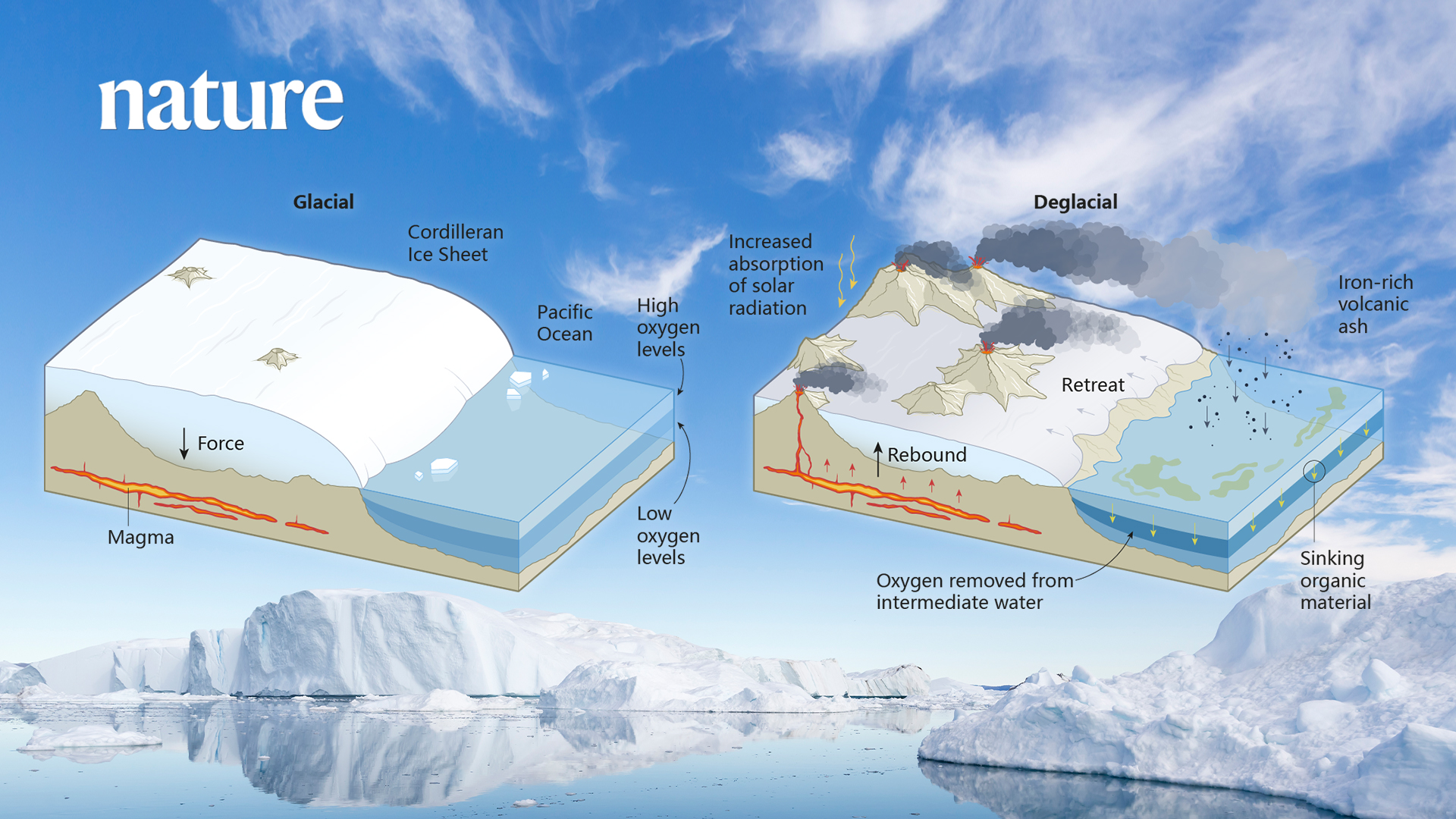The Cordilleran Ice Sheet was one of the major continental ice sheets that covered up to 2.5 million square kilometers of western North America during glacial periods over the last ~2.6 million years. The ice sheet reached a thickness of approximately two kilometers, similar to the Greenland Ice Sheet. The weight of such large ice sheets can cause the underlying crustal rocks to sink deeper into the mantle, often to the point that the land’s surface is below sea level.
When the ice sheet starts to melt, the crust rises again, and the subsequent re-organization of stress and pressure can trigger volcanic eruptions, as observed in regions like the Gulf of Alaska. The iron-rich ash resulting from the increased volcanism acts as a fertilizer, supercharging the production of organic matter in the surface waters. In turn, it exhausts all the oxygen in the underlying intermediate waters when it is remineralized.
In the meantime, the resulting ash layers decrease the reflectivity of the remaining ice fields and thus absorb more solar radiation, further accelerating melting, volcanic activity, and ocean deoxygenation. Recently, scientists from Oregon State University, ETH Zürich, and Texas A&M University (Du et al., 2022) proposed that the retreat of the Cordilleran Ice Sheet during the last deglacial warming has triggered short volcanic episodes, resulting in the northeastern Pacific Ocean hosting large oxygen-free ‘dead zones’ for millennia.

Associate Professor Weiqi Yao from the Department of Ocean Science and Engineering at the Southern University of Science and Technology (SUSTech) recently published an article commenting on how the melting of the Cordilleran ice sheet during the last deglacial warming triggered short volcanic episodes and marine “dead zones” that lasted millennia, and providing prospects for future ocean deoxygenation in a warming globe.
Her paper, entitled “Glaciers sparked volcanism harmed ocean health,” was published in the “News & Views” section of Nature, one of the world’s top academic journals.

Figure 1. The Cordilleran Ice Sheet retreat and regional isostatic rebound sparked deglacial volcanic eruptions and the subsequent biogeochemical processes and oceanic anoxia
With a focus on the trigger of deglacial volcanism and oceanic anoxia, Prof. Yao and co-author Prof. Ulrich G. Wortmann from the University of Toronto analyzed the vertical distribution of dissolved oxygen in the ocean. Light penetrates the 100 to 200 meters of water closest to the surface, where wind-induced turbulence, photosynthesis, and gas exchange with the atmosphere sustain high oxygen concentrations. Below the photic zone, the new organic material created by photosynthesis is exported into the underlying zone of the intermediate waters. The sinking organic matter decays, thus consuming oxygen in the surrounding waters. Since the intermediate waters have not been in contact with the atmosphere for decades, the oxygen concentration reaches its minimum at 200 to 1,000 meters below sea level (i.e., the so-called “oxygen minimum zone”). Although oxygen minimum zones are widespread in today’s oceans, the complete loss of oxygen is rarely observed.
The Gulf of Alaska provides the perfect example to examine the link between ice-sheet retreat, volcanism, and regional oceanic anoxia because it lies adjacent to the seismically active belt known as the “ring of fire” and contains large amounts of ice. The researchers commented that Du et al. findings are compelling, but their global relevance remains unclear. Future research will need to look for similar correlations in other places and at different times. Crucially, as a corollary, if short periods of iron fertilization can lead to long-lasting oxygen deficiencies in marine ecosystems, scientists need to reflect on the potential side effects of large-scale geoengineering ideas, such as using iron fertilization to increase carbon sequestration on ocean deoxygenation. Once waters are entirely devoid of dissolved oxygen, the resulting dead zones would harm marine ecosystems and fisheries.
More importantly, the planet is currently experiencing unprecedented challenges as a result of global warming. During the past 50 years alone, the total area of oxygen minimum zones increased fourfold, and this trend will continue to worsen. The loss of oxygen from the ocean impacts the world’s most extensive and least explored ecosystems, with unknown consequences for food security. Therefore, it is urgent to improve our understanding of how biogeochemical feedbacks affect the health of oceans in a warming globe.
Assoc. Prof. Weiqi Yao from SUSTech is the first and corresponding author of this paper. SUSTech is the first affiliation.
Paper link: https://doi.org/10.1038/d41586-022-03456-3
To read all stories about SUSTech science, subscribe to the monthly SUSTech Newsletter.
Proofread ByAdrian Cremin, Yingying XIA
Photo By